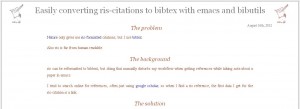 I have recently done a series of blogs on parsing Bibtex files. When I post a blog I tweet it with a #bibtex hashtag. Every so often I search for #bibtex in Twitter just to see what others are saying.
I have recently done a series of blogs on parsing Bibtex files. When I post a blog I tweet it with a #bibtex hashtag. Every so often I search for #bibtex in Twitter just to see what others are saying.
A recent search threw up an interesting web page. The blog post is interesting in that it shows another way of parsing citation information and getting it into bibtex (my posts have focussed on getting information out of bibtex). In this case it is the problem of getting RIS (Research Information Systems) formatted citations into bibtex format.
What is interesting about the post (apart from the fact that it provides a solution to the problem, especially if you face the problem!) is that it talks about disturbing workflow and how you can automate the task. Even if you can find a solution to the problem you face it often means having to go through many different stages, perhaps using different software packages and/or operating systems (in fact, I commented on this in my post on biber and biblatex). Once you have a solution that works when you need to return to it a few days/weeks/months/years later, unless you have documenated it (or have a very good memory), you may need to spend a lot of time working out what you actually did.
As I delve more into bibtex, and how to manipulate (or parse) the data I am gradually forming the opinion that there are standards in place but either they are not strict enough or people do not use them. For me a good example, is the use of names in bibtex (see here and here for a discussion).
The problem (or at least one of the problems) is that bibtex has a structured layout but within each element of that structure you can enter what you like, whether that is names not in the correct format or strange characters that do not display on every device.
Perhaps there is a standards agency that looks after these things, and perhaps I am missing something, but it seems to me that there are some areas for improvement in this important area.

I’m glad you like my post!
You could describe my emacs function as documenting the solution in such a way that it can be followed by emacs, so I don’t even have to read it myself the next tim I need it 🙂
Inside the bibtex files, there are rules, at least for multiple names, but I think they are only enforced by the bibliography package you use (or rather: the package breaks if you use them wrongly). A compatibility-checker for bibtext would be pretty nice, I think.
Thanks.
I agree a checker would be good.
Graham
Biber can convert from other format than bibtex to integrate in LaTeX.
Good reflections. By the way – I like the Firefox Add-In zotero. This converts RIS to Bibtex “easily”. It grabs a reference (e.g. something in RIS format) from the Website and with a click it is export to Bibtex.
If you want to avoid installing some software, there are a couple of online tools that do the job very well. I personnally like this one for RIS to bibtex:
http://www.bruot.org/ris2bib/
It uses the cb2bib library.